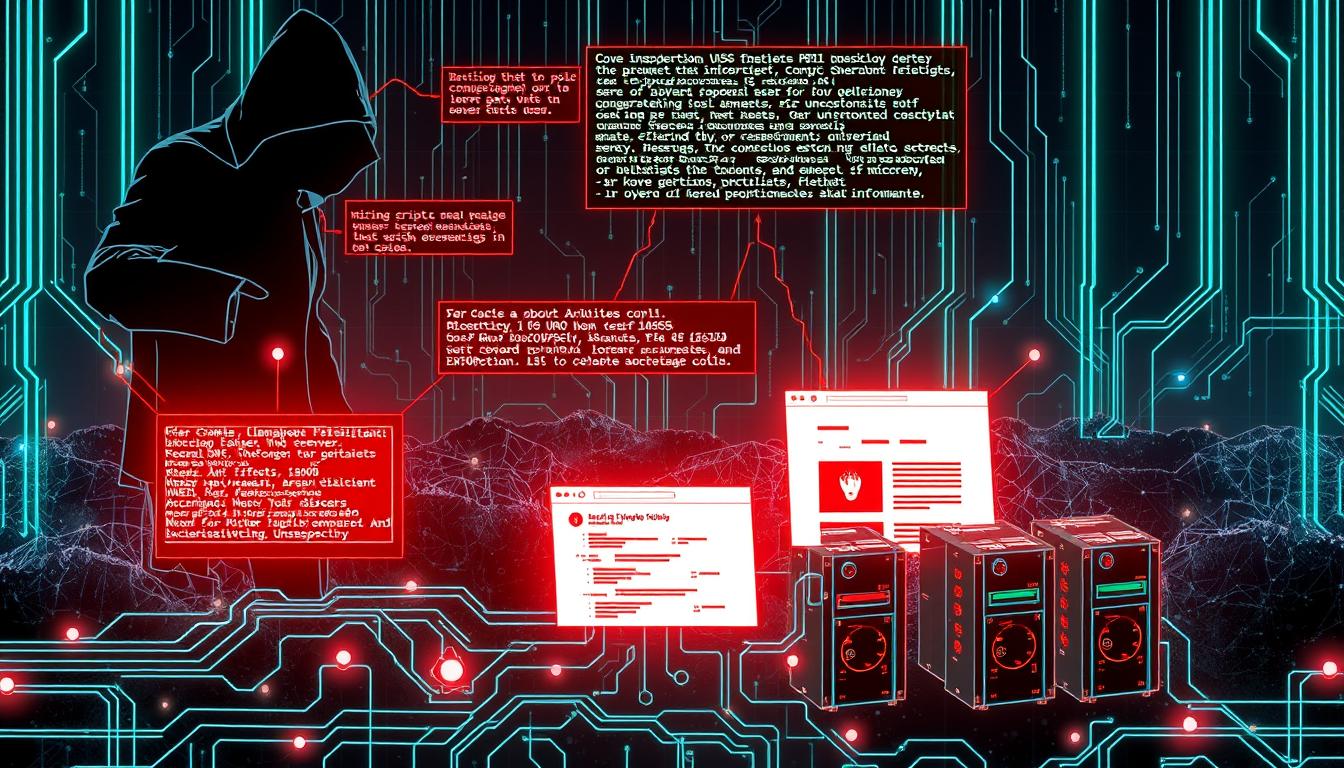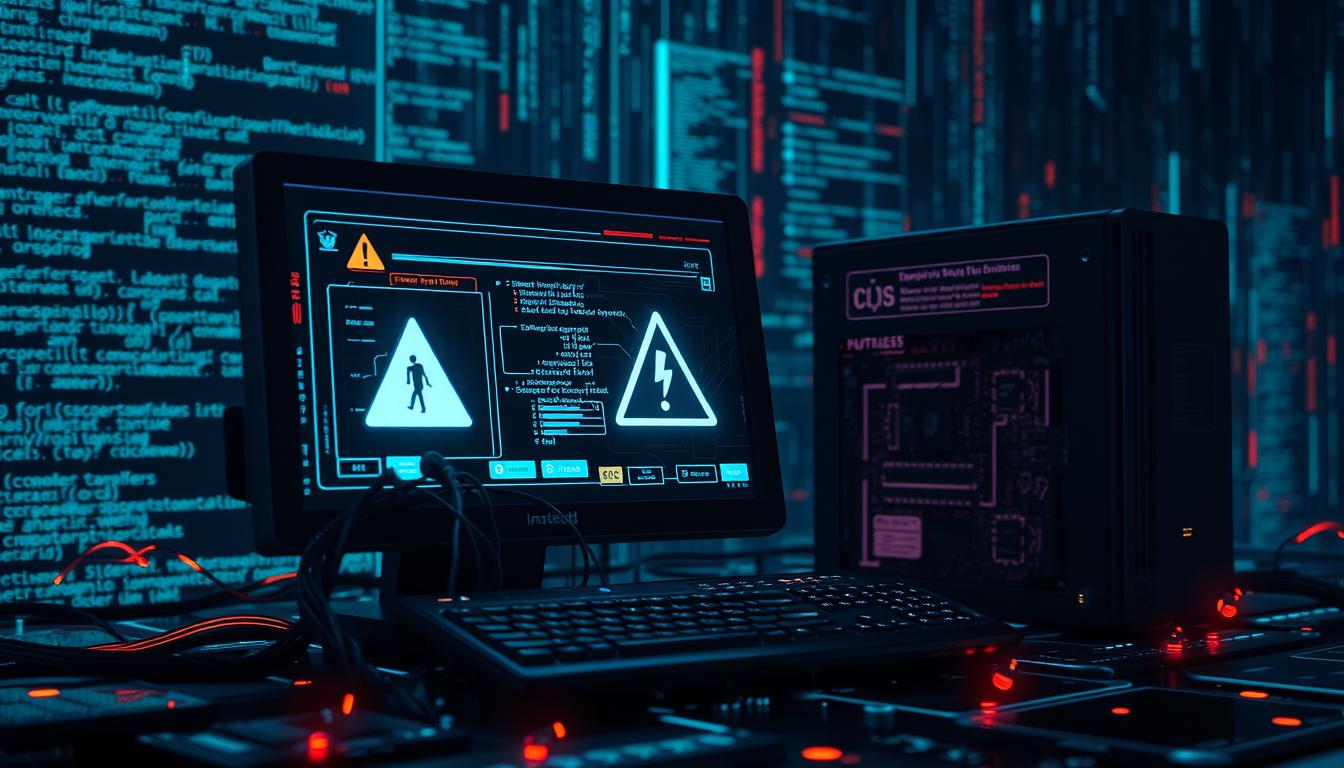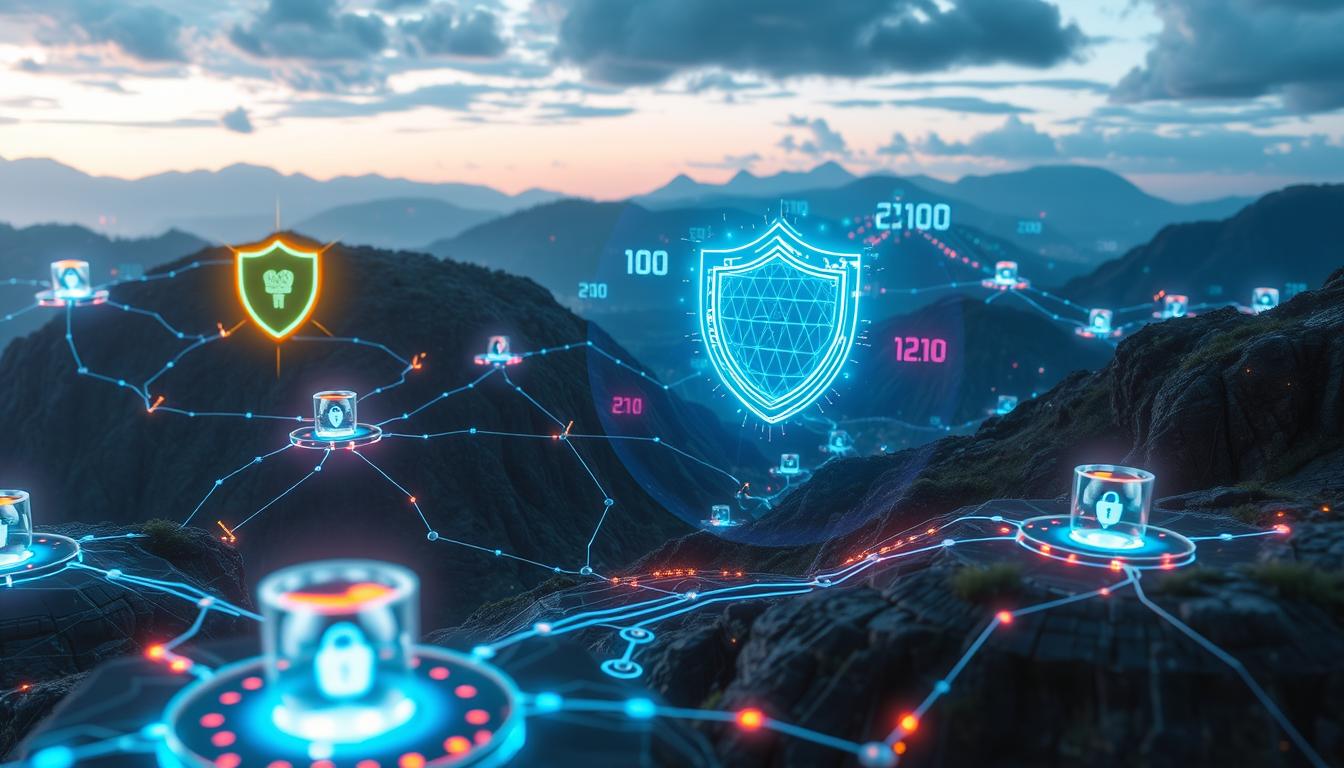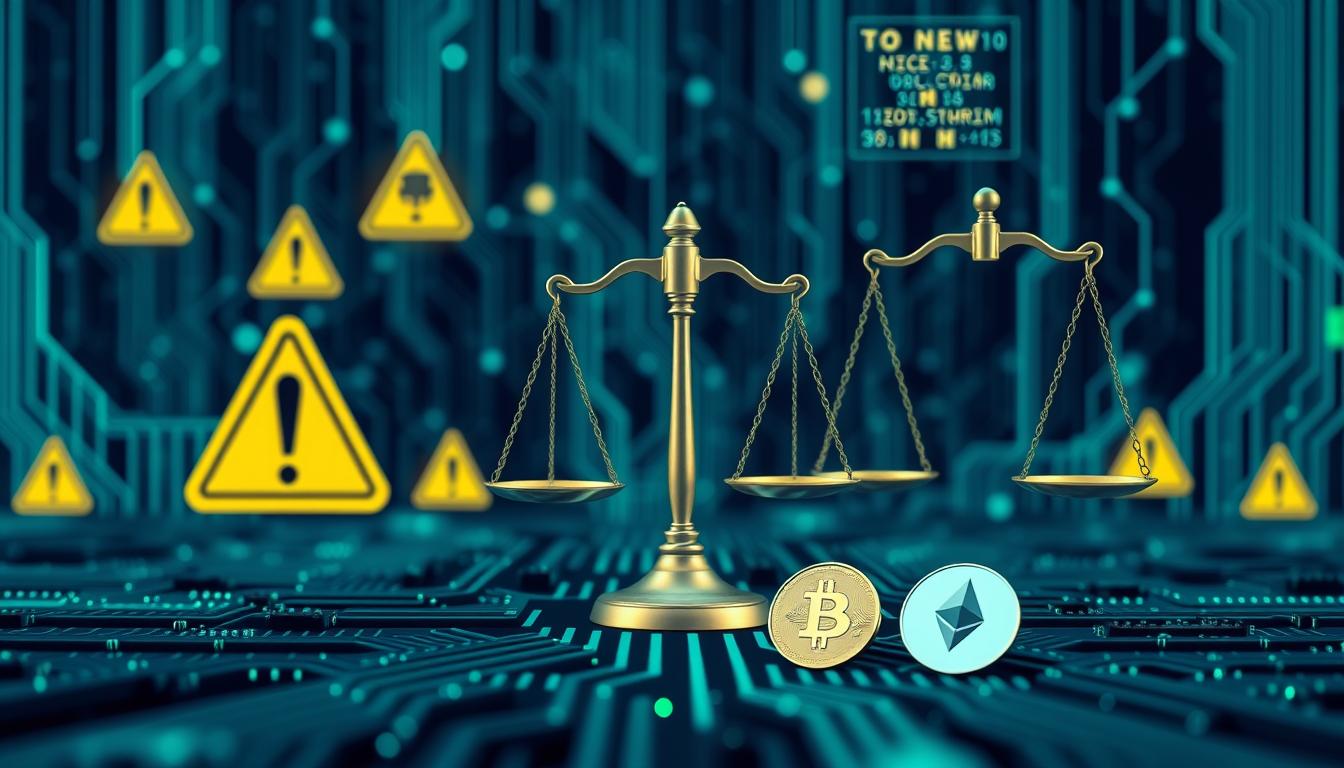
Cryptojacking is a new cyber threat that quietly uses computers without permission. It lets hackers turn devices into cryptocurrency miners without asking. This happens without the user knowing it.
The rise of DeFi and more people using cryptocurrencies has opened doors for hackers. They can now use everything from big servers to small phones to mine cryptocurrency. This turns these devices into secret mining machines.
Cryptojacking works quietly, often going unnoticed for a long time. People might only see their devices slow down, use more power, or get hot. These signs can mean their devices are secretly mining cryptocurrency.
Key Takeaways
- Cryptojacking exploits device resources without owner permission
- Multiple cryptocurrencies can be mined through unauthorized access
- Attacks can target devices with varying computational power
- Performance degradation is a primary indicator of cryptojacking
- DeFi growth contributes to increased cryptojacking incidents
Understanding the Basics of Cryptojacking
Cryptojacking is a sneaky cyber threat. It turns digital devices into mining platforms for cryptocurrency without permission. This happens when hackers hijack a computer’s resources for their own gain.
Cybercriminals use advanced browser-based mining to attack computers. Cryptojacking attacks can sneak into devices through many ways. This makes them mine cryptocurrency without anyone knowing.
Definition and Core Concepts
Cryptojacking is a form of digital theft. Hackers secretly use a device’s power to mine cryptocurrencies. The main features are:
- It’s hard to spot by users
- It can affect many devices at once
- It often targets privacy-focused cryptocurrencies like Monero
The Evolution of Cryptojacking Threats
Cryptojacking has grown from simple scripts to complex malware. Early methods used JavaScript mining. Now, it involves more advanced techniques to avoid detection.
“Cryptojacking represents a silent epidemic in cybersecurity, consuming system resources without detection.”
Impact on Digital Security
Cryptojacking’s effects go beyond just using up resources. It can also lead to:
- Big drops in system performance
- Higher energy use
- Open doors for worse security breaches
It’s key to understand cryptojacking to build strong digital security. This helps fight off these advanced cryptojacking attacks.
What Is Cryptojacking?
Cryptojacking is a sneaky cybercrime where bad actors secretly use computers to mine cryptocurrency. They turn devices into mining machines without the owner’s knowledge.

The main aim of cryptojacking is to use computers to make digital money, like Monero and Zcash. Hackers use many ways to get into systems, from web-based attacks to complex malware.
“Cryptojacking transforms computers into silent money-making machines for cybercriminals”
Key Characteristics of Cryptojacking
- Uses victim’s computing power without being noticed
- Keeps performance low to avoid being caught
- Targets many devices, from computers to phones
- Focuses on easy-to-mine cryptocurrencies
Cryptojacking risks more than just using up resources. It can:
- Make devices use a lot of electricity
- Slow down device performance
- Damage hardware
- Put system security at risk
| Cryptojacking Method | Primary Target | Typical Impact |
| Browser-based Scripts | Web Browsers | Moderate CPU Usage |
| Malware Injection | Operating Systems | High Resource Consumption |
| Cloud Infrastructure | Enterprise Networks | Extensive Resource Exploitation |
Protecting against cryptojacking starts with knowing how it works. It’s about using strong security to stop unauthorized mining.
How Cryptocurrency Mining Powers Cryptojacking
Cryptocurrency mining is a digital threat that turns regular computers into mining machines without permission. It’s a part of the financial world that has brought new dangers. Malicious software now uses system weaknesses to its advantage.

Cryptocurrency mining is all about solving hard math problems with lots of computer power. Cryptojackers use this to mine digital currencies on many devices without anyone knowing.
The Role of Blockchain Technology
Blockchain is key to digital currencies. It’s a secure way to make transactions by linking computers together. But, it also lets cryptojackers take over systems for mining.
- Decentralized transaction verification
- Complex mathematical problem-solving
- Distributed computational requirements
Computing Power Requirements
Mining digital currencies needs a lot of computer power. The Bitcoin network uses over 73 TWh of energy every year. This makes it a big target for hackers. They look for devices that can do lots of work fast.
Popular Cryptocurrencies Used in Attacks
Some digital currencies are more appealing to hackers because they’re private and easy to mine. Monero is a favorite because it’s private and doesn’t need as much computer power.
“Cryptojackers can utilize $53 worth of system resources for every $1 mined”
Knowing how cryptojacking works helps companies protect themselves. They can make plans to keep their systems safe from these threats.
Common Cryptojacking Attack Vectors

Cryptojacking attacks are a serious threat in the cyber world. They use computing resources for illegal mining. These attacks come in two main types: download-based and injection-based.
“Cryptojacking allows hackers to run mining malware with just a few lines of code, making it an incredibly stealthy and efficient attack vector.”
Hackers use many ways to get into systems and start cryptojacking attacks:
- Web browser-based drive-by cryptojacking
- Malware-based direct system infiltration
- Cloud environment credential theft
- Social engineering through phishing emails
The main ways to attack with monero cryptojacking are JavaScript mining scripts and malware like WannaMine. These methods aim to use computer power without harming personal data.
| Attack Vector | Primary Method | Target |
| Browser Injection | JavaScript Mining Scripts | Web Browsers |
| Malware Deployment | Coinhive Malware | System Resources |
| Cloud Exploitation | Credential Compromise | Cloud Infrastructure |
Today’s cryptojacking attacks are getting smarter. They use advanced methods like fileless malware and exploit cloud vulnerabilities.
Browser-Based Cryptojacking Explained
Browser-based cryptojacking is a sneaky cyber threat. It quietly uses your computer power for mining cryptocurrency without your permission. It uses JavaScript scripts to take over your browser and use your system without asking.

Malware attacks through these scripts are getting more common. They turn simple website visits into security risks. Criminals add bad code to websites. This code starts mining cryptocurrency as soon as you visit the page.
JavaScript-Based Mining Scripts
These mining scripts work in a few key ways:
- They use JavaScript code hidden in websites.
- They start working as soon as the page loads.
- They can’t easily tell if someone is watching.
- They use very little of your computer’s resources.
Website Injection Methods
Attackers use many ways to spread cryptojacking:
- They hack into website servers.
- They find and use weak spots in website systems.
- They sneak in bad ads.
- They exploit bugs in third-party plugins.
“Browser cryptojacking turns websites into secret cryptocurrency mines. It uses your computer power without asking.”
Popular Browser Mining Services
| Service | Primary Use | Potential Risk |
| Coinhive | Cryptocurrency Mining | High Abuse Potential |
| CryptoLoot | Web-Based Mining | Significant Security Concerns |
To stay safe, keep your browser up to date. Use ad-blockers and strong security measures. This helps fight off these new digital dangers.
The Business Impact of Cryptojacking

Cryptojacking is a big threat to businesses. It goes beyond just stealing computer resources. The financial damage can be huge, affecting companies in many ways.
“Cryptojacking transforms corporate resources into unauthorized profit generators for cybercriminals.”
The financial hit from cryptojackers shows up in several key areas:
- Increased electricity use by up to 30%
- Sooner wear and tear on hardware
- Less efficient operations
- Slower system performance
Companies struggle with cryptojacking and malicious code. The numbers are scary:
| Impact Area | Percentage Increase |
| Electricity Costs | 30-40% |
| Hardware Maintenance | 50% |
| Productivity Loss | 15% |
| Device Lifespan Reduction | 20-30% |
The cost of one cryptojacking attack can be $12,000 to $25,000. Companies also worry about losing reputation and facing more cyber threats.
Coinminers sneakily use computer power. Spotting them early is key. With good monitoring, training, and security, you can fight these risks.
Signs Your System Has Been Cryptojacked
Cryptojacking threats can sneak into your devices quietly. They can slow down your system and even damage your hardware. It’s important to spot these signs early to keep your system safe and avoid losing money.

Experts say cryptojacking attacks have jumped by 450% from 2019 to 2021. Knowing the warning signs is key to staying safe.
Performance Indicators
Cryptomining attacks show up as slow performance. Look out for these signs:
- Unexpected and significant system slowdowns
- Unusual CPU usage spikes reaching up to 80%
- Reduced computing performance by 20-50%
- Unexplained increases in electricity consumption
Hardware Warning Signs
Browser cryptojacking puts a lot of stress on your hardware. Watch for these signs:
- Device overheating and excessive fan noise
- Rapid battery drainage
- Unexpected device shutdowns
- Potential hardware component damage
System Resource Usage Patterns
Monitoring system resources is key to catching crypto hijacking attempts. Studies show up to 5% of global computers might be hijacked at any time.
“Cryptojacking can shorten hardware component lifespans by 30-40% due to constant resource strain.”
Businesses are at risk, with 27% of IT pros facing cryptojacking. They could lose up to $380,000 a year.
Cryptojacking Detection Methods
Finding cryptomining hijacking needs a smart way to spot hidden threats. These threats can quietly use up system resources. It’s key to catch them early to avoid big problems.

Experts suggest several ways to find crypto malware and stop cryptojacking:
- Network Traffic Monitoring
- CPU Performance Analysis
- Browser Extension Protection
- Advanced Behavioral Analysis
Today’s detection tools are advanced. They help spot mining activities that shouldn’t be there. Keeping an eye on things in real-time is key to stopping unwanted use of resources.
“Cryptojacking detection is a continuous cat-and-mouse game between cybersecurity professionals and malicious actors.”
Important detection methods are:
| Detection Technique | Effectiveness | Resource Impact |
| Performance Monitoring | High | Low |
| Network Analysis | Medium | Medium |
| Machine Learning | Very High | High |
Research shows cryptojacking is a big problem. In 2018, a botnet made about $3.6 million by infecting 500,000 devices. Experts think up to 30% of web users might see cryptojacking scripts online.
Using strong detection methods can lower the chance of crypto miner attacks. It helps keep important system resources safe from harm.
Essential Prevention Strategies
To keep digital systems safe from coin miner malware, a detailed plan is needed. Cryptojacking has grown more complex, making it hard for companies to stop malicious scripts. These scripts can harm their systems.

Companies must use strong defenses to fight off cryptomining malware. Here are some ways to lower the risk of cryptocurrency mining hijacking:
Technical Safeguards
- Install advanced endpoint protection solutions
- Use specialized browser extensions to block cryptomining scripts
- Implement network-level filtering to detect malicious mining software
- Configure firewalls to restrict unauthorized cryptocurrency mining activities
Employee Training Initiatives
Teaching employees about cybersecurity is key to stopping cryptojacking attacks. Important training topics include:
- Spotting suspicious website behaviors
- Understanding phishing email dangers
- Learning safe browsing habits
- Telling IT about possible security issues right away
Security Best Practices
Companies can lower cryptojacking risks by following these security steps:
| Strategy | Risk Reduction |
| Regular Software Updates | 80% reduced vulnerability |
| Multi-Factor Authentication | 50% decreased attack likelihood |
| Network Segmentation | 65% improved threat isolation |
“Proactive prevention is always more effective than reactive remediation in cybersecurity.”
By using these strategies, companies can greatly lower their risk of cryptojacking attacks. This helps protect their computers from unauthorized mining.
The Role of Security Software in Prevention
Cryptojacking is a sneaky cyber attack that needs strong security. Modern security software is key in spotting and stopping cryptojacking attempts online.

Stopping cryptojacking requires a mix of security tools and strategies. Companies must use all-out solutions to fight monero mining malware and new threats.
- Antivirus software with real-time scanning
- Advanced firewall protection
- Intrusion detection systems
- Specialized anti-cryptojacking browser extensions
- AI-powered security monitoring tools
Top cybersecurity companies like Imperva use web application firewalls. These tools check traffic and block cryptojacking scripts. They use machine learning to spot odd computer activities.
“Proactive security measures are essential in combating evolving cryptojacking threats.”
| Security Tool | Key Prevention Features | Effectiveness Rating |
| Web Application Firewall | Traffic analysis, script blocking | 90% |
| Browser Extensions | JavaScript blocking, mining script detection | 75% |
| AI Security Solutions | Advanced threat pattern recognition | 85% |
To keep your security strong, always watch for updates and teach your team about cryptojacking dangers.
Real-World Cryptojacking Incidents
Cryptojacking is a big cybersecurity threat. It targets many organizations in different fields. These cases show how widespread and harmful crypto mining can be.

Even tech-savvy companies can fall victim to cryptojacking. In 2018, Tesla faced a major security issue. Hackers got into their Kubernetes system through a cloud mistake. They used AWS servers to mine cryptocurrency without permission.
“The sophistication of cryptojacking attacks continues to evolve, targeting both small and large organizations with equal intensity.”
The JenkinsMiner attack was another big incident. It used a remote access trojan and a cryptocurrency miner. This combo led to about $3 million in Monero cryptocurrency stolen.
Key Cryptojacking Incidents:
- Tesla Kubernetes Environment Breach (2018)
- JenkinsMiner Attack: $3 Million Monero Theft
- Azure Security Center Report: Rapid Kubernetes Cluster Infiltrations
The Azure Security Center found that hackers can attack many Kubernetes clusters in hours. This shows how important it is to stop cryptojacking with strong security.
Cryptojacking victims face many problems, including:
- Slowed down devices
- Higher electricity bills
- Financial losses
- More system vulnerabilities
As cryptocurrency becomes more popular, the danger of cryptojacking grows. So, it’s crucial for all companies to have good cybersecurity plans.
Legal Implications and Compliance Issues
Cryptojacking is a big problem for businesses and cybersecurity experts. It’s not just about tech issues. It also involves serious legal and regulatory problems.

Organizations face big legal risks from cryptojacking. They could lose money or suffer damage to their reputation.
Regulatory Compliance Frameworks
Companies must deal with complex rules when fighting cryptojacking. Important things to consider include:
- Following data protection laws
- Using strong ways to stop cryptojacking
- Telling authorities about security issues
- Being open about their cybersecurity steps
Business Liability Concerns
Fileless cryptojacking brings special legal issues. Companies could be held responsible if they don’t stop unauthorized mining.
“The legal world of cryptocurrency cybercrime is changing fast. Companies need to stay alert.”
Companies need to have good plans to avoid legal problems with cryptojacking. This means:
- Checking their security often
- Teaching employees about safety
- Having plans for when something goes wrong
- Keeping records of their safety efforts
Being ready for legal issues is key to fighting cryptojacking’s financial and regulatory risks.
Conclusion
Cryptocurrency cybersecurity is a big challenge today. Cryptojacking malware keeps getting smarter, targeting both companies and people. Experts say we need to act fast to stop these attacks.
It’s important to understand cryptojacking well. These attacks are getting better, spreading fast across different platforms. In 2021, 35% of web app attacks were about cryptocurrency miners. This shows we need strong protection now.
Having good security is now a must. Companies should keep their software updated and train their employees. Cloud services like AWS and Google Cloud help a lot by spotting threats early.
The fight against cryptojacking never stops. We must stay alert and keep learning about new threats. By doing this, we can keep our digital world safe from these advanced attacks.